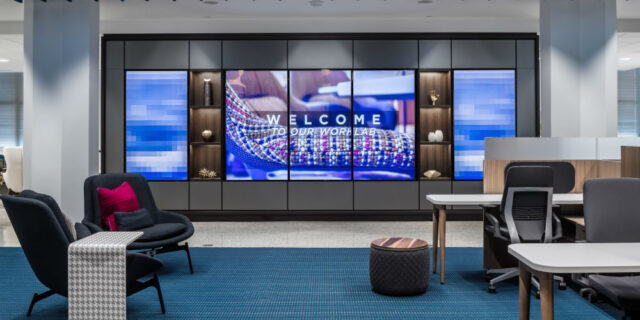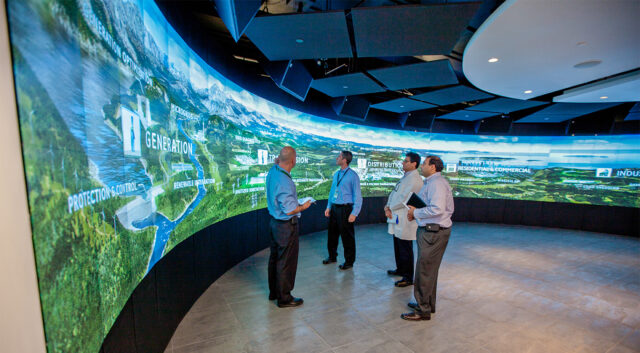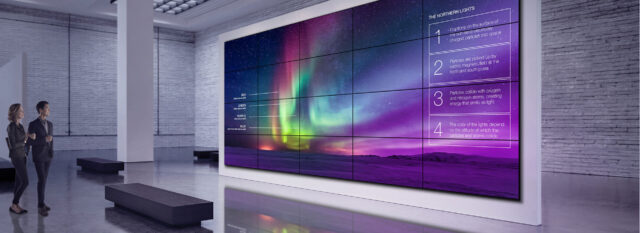
Video walls are becoming more popular as a way for companies to bridge the gap between physical and virtual environments, especially in the case of large-scale events such as conferences. It helps them collaborate and creates a sense of belonging in a virtual world. Another byproduct is that they make employees feel closer to their workplace without physically being there.
The trend of having video walls in the office is becoming more and more popular with companies like Samsung, LG, Microsoft, Dell, and many other tech giants investing in this technology. However, video walls also require a lot of hardware, which typically is not affordable for the average business. LED and LCD screens are perfect for video walls because they come with high contrast ratios and better resolution than standard LCD screen monitors.
According to Userful.com large video walls can also be seen in some public places today. Video walls display live footage from an event or sporting event, displaying action in 3D. These screens are also capable of supporting a higher number of simultaneous viewers, which is why they are used at large events such as sports stadiums and concerts.
The Benefits of Video Walls
As technology continues to develop, the way we interact with each other is changing. One form of that change is in the way we communicate with each other. As a result, people are likely to use video walls as their primary means of interaction at work and home.
Video walls are sets of multiple screens which are usually connected to the same computer. A video wall is an effective and attractive way to broadcast information, as it is much easier for audiences to see everything on a screen rather than on a single monitor. While video walls are expensive, they are still cheaper and more accessible than traditional immersive technologies like VR and AR.
Benefits for businesses:

Video walls provide a much more immersive experience than traditional screens. They also allow for easy switching between different projects and multiple functions to be performed simultaneously such as creating content, editing videos, conducting meetings, and answering emails. They are being used as an interactive display to enhance interactions with consumers and employees. Video walls provide benefits such as improved customer experience, increased employee engagement, decreased cost per employee, and improved communication efficiency among others.
Video walls also offer the advantage of being able to display high-resolution content on any screen size, making them ideal for marketing applications such as digital signage and retail displays. Video walls have rapidly become the preferred option for digital signage because they are easy to use and offer a multitude of benefits, such as increased brand equity and attention span. They also allow businesses to create engaging and dynamic content that is a captivating experience for their audience. Video walls can also be used to encourage people to take action in a specific way, like signing up for a service.
Benefits for students:

Video walls are typically used in classrooms for group activities and are helpful because they allow students to participate without having to worry about disturbing others or not being able to see what is happening around them. They can also be used by older students who are sitting in their classrooms so they can watch a lecture or an online video with more ease and without distraction. Video walls also provide a level of immediacy and engagement that is often impossible in traditional classrooms.
Benefits for the general public:

The use of video walls is expected to grow because of their benefits such as being able to watch sporting events and other live broadcasts on a larger scale. They create an immersive experience for viewers. They are also installed in places like airports, museums, convention centers, schools, and shopping malls so people can enjoy these videos without having to go through the hassle of going outside or finding a space with a lot of screens.
Challenges of Using Video Walls

Some of these challenges include cost and scalability. Video walls consume a lot of power and they need to be constantly on. The major challenge is how companies can justify the use of this technology in their particular scenario because it is quite expensive when compared to other technologies that can be used for similar tasks. They are also difficult to scale as the number of screens increases.
How to Choose the Best Type of Video Walls for your Needs

One of the most important factors to consider when choosing between types of video walls is their size. The bigger the screen, the more impact it will have on the audience members’ emotions and overall perception. The type of display technology also has a major impact on the cost, resolution, and brightness. You should know your target audience and what they expect from your brand before buying this tech for your business or venue.
LCD or LED?
The answer lies in the type of display content you want to project. For static content, LED is best because it uses less power and is less prone to burn-in. For dynamic content, LCD is best because it has brighter colors and can be switched on quickly. However, if you need a solid color background for your videos or pictures, then LED displays are a better option than LCDs as they can display a single solid color without any flickering.
LCD: This type of display is used in flat-panel TVs and computers alike. One downside to this type of display is that it typically has poor viewing angles and it takes longer to refresh an image than other types of displays do.
LED: LEDs have better viewing angles and are more energy-efficient. One disadvantage of LED screens is that they need an extra display power controller for each pixel to control the brightness and contrast when you switch between different content or change the orientation.
Video walls are already bridging the virtual chasm, as seen by the uptick in installation of video walls during the pandemic. So, who knows what the future holds but it seems probable that they will become even more popular in the future.









